Flat-out fast bikes ready for a life between the tape or high-speed razzing around your local trails

Cross-country is booming. At the top level, the XC World Cup is providing some of the most exciting, close-quarters racing that cycling has to offer, with big names and newcomers alike taking chunks out of each other on technical tracks. And, excitingly, this is going to be showcased to the world at this summer’s Olympic Games. Back here in the UK, the race scene is healthier than ever, with bigger fields of riders tackling events across the country.
But it’s not just the racing that’s having a growth spurt. XC tech is undergoing some of the biggest changes we’ve seen for decades, as manufacturers battle to provide their riders with bikes that’ll gain altitude as fast as ever, while absolutely shredding the descents. Whips, turn-downs, manuals and gap jumps are a common sight at XC races these days, and nobody wants to be left in the dust.
So, if you’re a budding XC whippet, what bike should you buy? To find out, we’ve pulled together four brand-spanking new race bikes and pitted them against each other to find out which one leaves you with no excuses to finish anywhere but on the top step of the podium. While World Cup-level bikes are eye-wateringly expensive, all our rigs are second- or third-tier models. They’re still pricey, but ideal for the UK racer who has relatively deep pockets but doesn’t have access a bottomless money pit. All four feature 110 to 120mm of suspension and geometry that wouldn’t look out of place on a trail bike.
To test them, we took them on long XC runs in the Cotswolds, which were ideal for assessing day-long comfort and pedalling efficiency. Laps in the woods helped us gauge their ability to crawl up steep climbs, winch over roots and slip through mud. And, to mirror the excitement of this year’s first two XC World Cup round in Brazil, we even gave them a pummelling down some of BikePark Wales’s roughest tracks. How well did they handle these trails? You’re about to find out…
MEET THE TESTER
TOM MARVIN
SENIOR TECH EDITOR
Tom’s riding started with cross-country, over 20 years ago, and since then he’s ridden dozens of race bikes. Over the years, he’s lined up for everything from grassroots events to multi-day marathons in far-flung places. Outside of the race tape, he still loves the taste of blood, apparently, because he thinks nothing of chucking short-travel bikes down trails they’re not normally seen on.
THE BIKES ON TEST
MONDRAKER F-PODIUM RR
£7,699
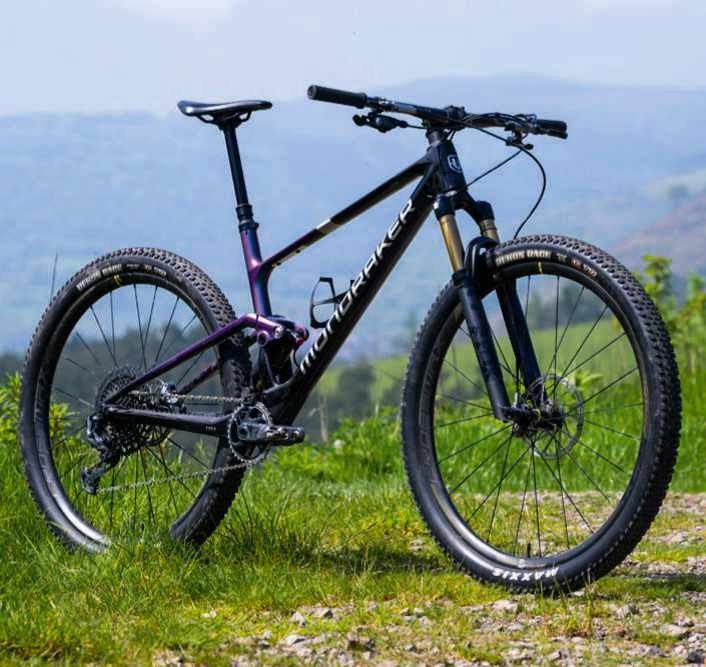
As the first mass-market brand to go properly long, low and slack, it’s no surprise Mondraker’s 110mm-travel XC rig has a shape straight from the trail bike playbook. This latest F-Podium has a revised linkage, with the bottom shock mount on the swingarm rather than the lower rotating link. Although the top tube looks skinny from the side, it’s broad, ensuring ample stiffness as you haul on the bar and apply power via the Mavic carbon wheels.
SPECIALIZED EPIC 8 PRO
£8,000

In this year’s XC World Cup, the new Epic has shown incredible early-season form. It’s got notably long, low and slack geometry, plus a ‘secret’ weapon – the custom ‘Magic Middle’ setting on its RockShox SIDLuxe shock. This replaces the ‘Brain’ tech found on Epics for the past couple of decades, and is designed to be a do-it-all mode for 80 per cent of your riding time, signifying a significant change of direction from Specialized.
YETI ASR T3
£8,399
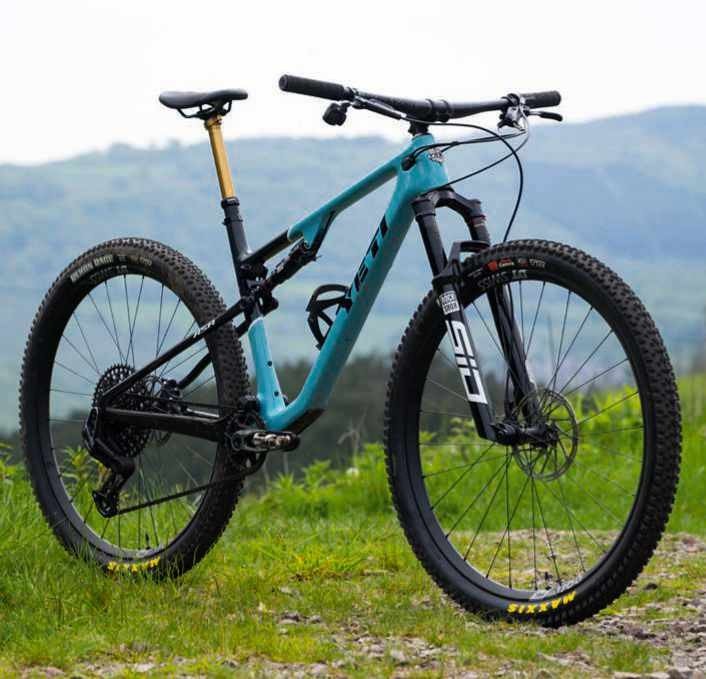
The ASR is fresh to market and has 115mm of rear-wheel travel, paired – as on all the bikes tested – with a 120mm fork. Like the Cannondale and Specialized, its suspension design relies on flex in the carbon back end, rather than a rear pivot – an approach Yeti first used on their XC bikes way back in 2003. The Yeti is the only model here without carbon wheels, but you do get a slick-shifting, wireless SRAM X0 Eagle Transmission.
CANNONDALE SCALPEL LEFTY 1
£8,550
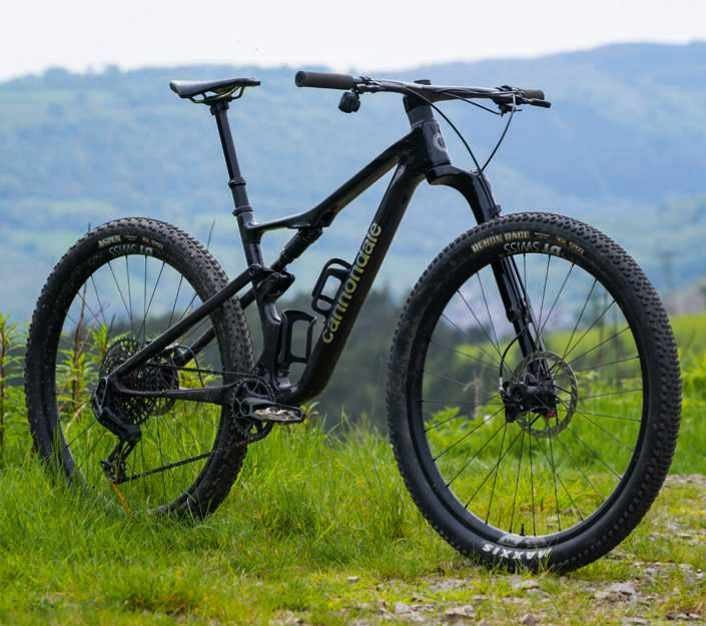
Cannondale’s one-sided Lefty Ocho Carbon fork turns heads and is a smooth operator, even under significant loads. Out back, the Scalpel has 120mm of travel, with flattened chainstays mimicking the functionality of a rear pivot. Fast wheels – Maxxis Rekon Race and Aspen tyres on DT Swiss carbon rims – help provide a rapid, ‘get up and go’ feel.
MONDRAKER F-PODIUM RR
£7,699
Is Mondraker’s race bike destined for the top step?

DETAILS
CLEAR-HEADED
Headset-routed cables look ‘clean’, but can increase workshop time during maintenance. One benefit is shorter sections of outer cable, which are less likely to get snagged.
OLD FAITHFUL
While not as flashy as SRAM’s latest wireless Transmissions, the mechanical GX Eagle drivetrain here is a solid performer, with quick, reliable shifting (if well-maintained) and cheaper replacement parts.
SOFT TOUCH
Fox’s FIT4 fork damper has a three-position low-speed compression dial (open/medium/firm), plus incremental adjustment of the open mode, to help you dial in just the right balance of sensitivity and support.
Mondraker have merged their purebred F-Podium XC rig with the ‘downcountry’ DC variant to create this do-it-all package targeting the top step of the podium. It uses an updated version of the brand’s Zero Suspension System, and draws upon their pioneering Forward Geometry concept.
THE FRAME
The other bikes here all use a variation on a four-bar linkage or single-pivot suspension design with flexstays in place of a rear pivot, but Mondraker stick with their twin-link Zero system. This delivers a ‘virtual’ pivot point, which varies throughout the travel, potentially giving more control over pedal bob. The shock attaches to the rear triangle, not the lower link as usual, and sits low and central in the frame. A pair of rubberised fenders protect it, but – combined with its location between two frame struts – make it difficult to measure sag.
Although thin in profile, the top tube is reassuringly broad when viewed from above, hinting at a stiff chassis – something aided by a non-driveside rear brace. The low-slung frame only has a single set of bottle bosses, but there’s a tool mount under the top tube, plus some chainslap protection.
THE KIT
Fox supply their top-end, Factory-level 34 Step-Cast fork and FLOAT shock. Both offer three-position low-speed compression damping adjustment, via a shifter-style on-bar remote. This firms things up in single clicks, then releases to fully open. The fork’s FIT4 damper offers additional open-mode adjustment, to further fine-tune the feel. With the lockout taking up real estate on the left of the bar, dropper post actuation is relegated to an over-bar lever, which takes getting used to.
Two-piston SRAM Level brakes and a mechanical GX Eagle groupset (with X1 cranks and X01 mech) provide the stop and go. The bike rolls on Mavic carbon wheels shod with 120tpi Maxxis Recon Race tyres. Finishing kit is from Mondraker’s in-house brand OnOff.
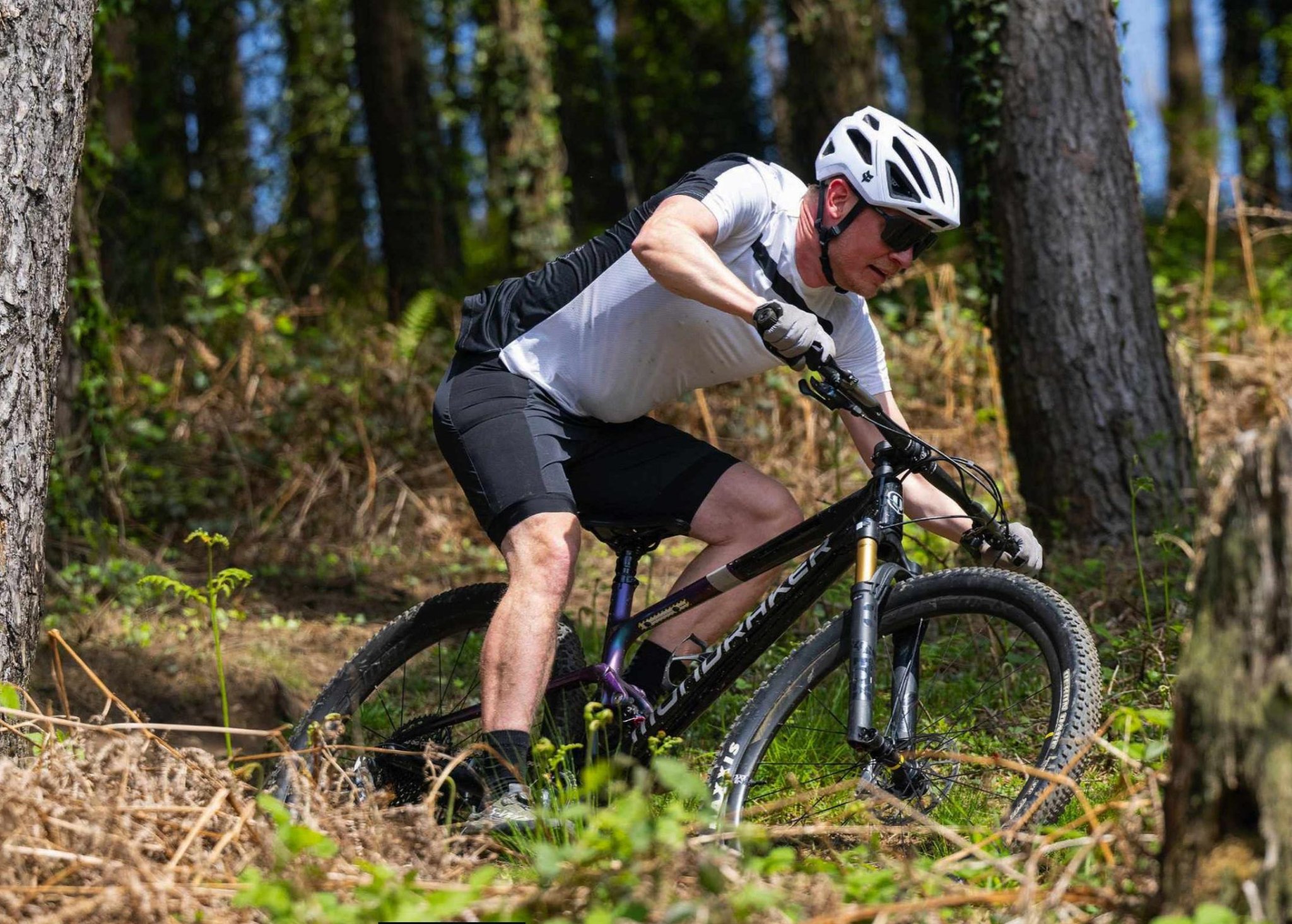
THE RIDE
Flexstays may be dominant in XC, but Mondraker’s Zero system works well in this application, too. We settled on a fairly soft set-up, running 28-30 per cent sag, which helps the rear wheel track the ground, increasing grip, comfort and, ultimately, speed. It does make the bike bob a little more under pedalling, so we found ourselves using the under-bar lever regularly. Switching to the medium mode filters out most of the bob, so is good for climbing, and also for smooth flow tracks, where it still allows the rear wheel to hug steppy rocks and roots, ensuring that the tyre can continue delivering drive.
The Fox 34 fork has a more damped feel than the RockShox SID specced elsewhere in this test. This means it remains composed over repeated big hits and stable as you load it up through berms or drop into steep chutes. However, it soaks up fast chatter less effectively than the SID.
Mondraker have specced a medium tune on the shock, which provides a good balance with the fork. We wonder whether a lighter tune would help smooth the way, as well as reduce pedal bob (because you could run higher pressures), but it’d have to be paired with a suppler fork to avoid upsetting the balance of the bike.
As we’ve come to expect from Mondraker, the geometry is great. The long 1,208mm wheelbase on our large size and the slack (for XC) 66.5-degree head angle give plenty of high-speed stability, while the low-ish BB and solid tyres mean the bike rips through corners and shines on steeper terrain.
This is the only bike here without wireless shifting, and it’s a good reminder of just how nicely a well set up mechanical drivetrain can work. The cabled GX Eagle changes gear exactly when you want, unlike SRAM’s AXS Transmissions, which wait for the perfect moment to push the chain over the cassette’s shifting ramps. It’ll also be cheaper to replace any worn parts. We like the Mavic wheels, too, which give good tyre volume, and are neither uncomfortable nor flexy. The bar feel is a little harsh, though, due to the thin grips and supportive fork damper. https://mondraker.com
HIGHS
Sorted geometry gives you confidence to tackle any terrain
Rips around both fast and steep tracks
LOWS
Suspension damping gives a rougher ride than some over choppy terrain
Hard-to-access shock frustrates during set-up
FOR A LOT MORE
Mondraker F-Podium RR SL
£10,799
Wireless shifting, RockShox suspension and an electronic Reverb AXS dropper post feature on this model.
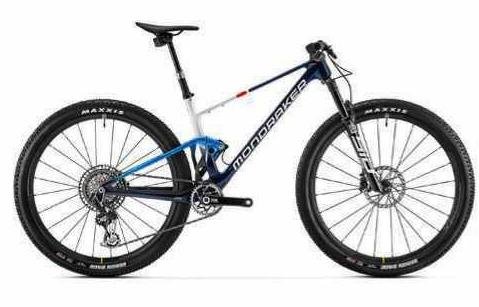
FOR A LOT LESS
Mondraker F-Podium R
£6,299
Performance-level Fox suspension and a non-upgraded GX Eagle drivetrain lower the price, but you still get carbon hoops.
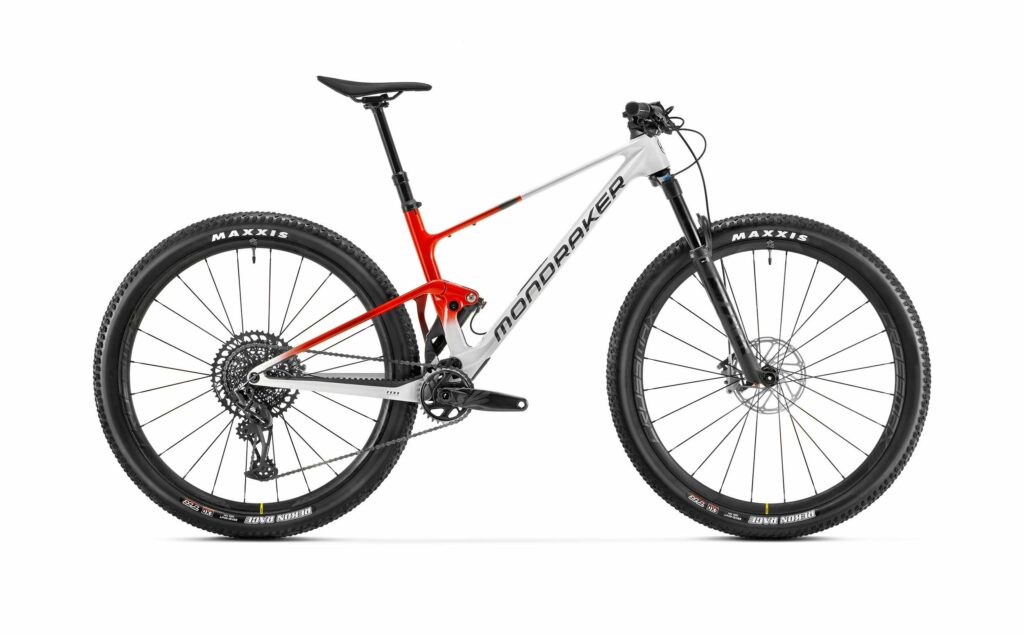
YETI ASR T3
£8,399
A decade after its departure, the ASR is back in action

DETAILS
GOOD GUIDE
A dropped chain can lose you a race. While there’s a stiff clutch mechanism built into the rear mech, Yeti also fit a lightweight chain guide, for extra peace of mind.
ALLOYED FORCES
Alloy rims weigh around 200g more than carbon ones, but often feel smoother on the trail. The rim walls can also be more forgiving to tyres on harsh hits, reducing the chance of pinch punctures.
QUIET CABLES
Small bolts on the entry and exit points of the ASR’s internal cable routing help keep internal rattles at bay.
Yeti have a long history in racing. Recently, their focus has been largely on enduro, but there’s now an XC rig in their line-up once more, after a 10-year hiatus. The Colorado brand have removed as much redundant carbon fibre as possible from the ASR’s frame, to keep weight to a minimum. They’ve also eschewed their usual complex Switch Infinity suspension set-up for a flexstay arrangement.
THE FRAME
The front and rear triangles are both made from carbon fibre. Yeti use individually-shaped carbon sheets, both to reduce excess material and allow size-specific frame stiffnesses. The shock is actuated by an aluminium rocker link, which pivots on a mount integrated into the top tube/seat tube junction, minimising the amount of material needed.
Flexstay designs vary. Here, it’s the seatstays rather than the chainstays that bow as the suspension compresses, effectively making the ASR a single-pivot bike with linkage-driven shock. There’s 115mm of rear-wheel travel.
A pair of bottle cages can be fitted, and thin chainstay and down tube protection is provided. Cables enter the frame through bolted ports on the head tube. Geometry includes a slack 66.5-degree head angle and steep 76.5-degree (measured) seat tube angle, paired, on our large frame, with a moderate 465mm reach.
THE KIT
This second-tier model comes specced with plenty of race-ready kit, including a 120mm-travel RockShox SID Ultimate fork and matching SIDLuxe shock, paired with a three-position TwistLoc remote to firm things up. SRAM supply their wireless X0 Eagle AXS Transmission, and the pod shifter sits on a Race Face Next SL carbon bar. The Fox Transfer SL Factory seatpost offers two drop positions, 150mm of travel, and a very light and fast operation, while two-piston SRAM Level brakes offer reasonable stopping power. Alloy DT Swiss wheels are shod with Maxxis rubber – a Rekon up front and faster Rekon Race at the back.
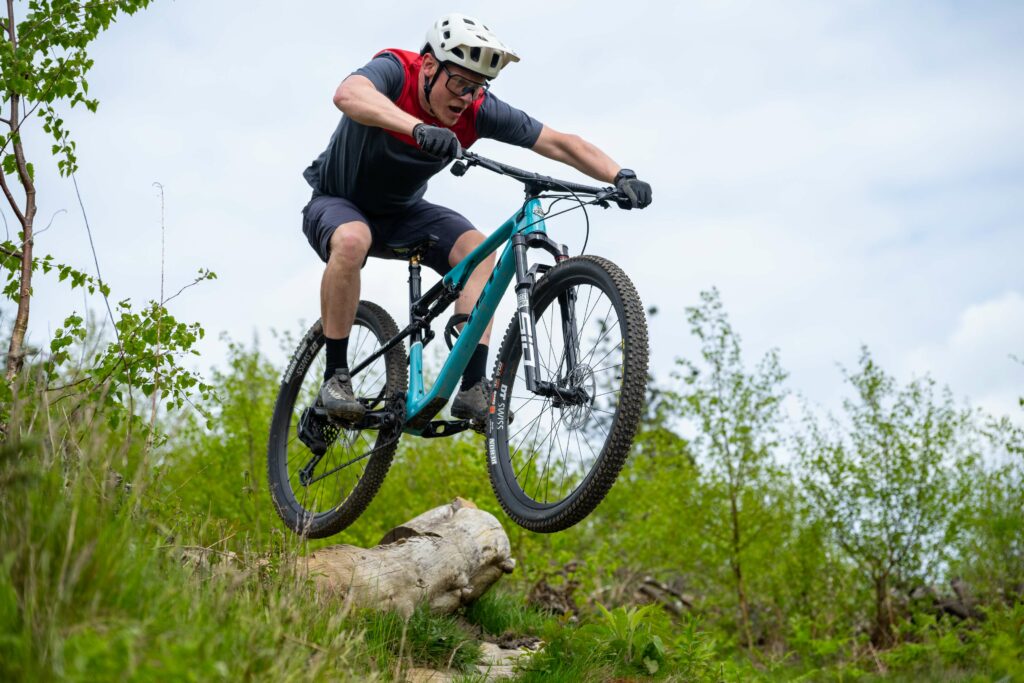
THE RIDE
Jumping on a Yeti always feels special, and the ASR is no different. Its sleek lines give it a race-bike look, and the brand’s turquoise paint is iconic. While the reach is only 10mm or so shorter than on the other bikes here, the ASR feels a little more compact. In tight, twisty terrain we loved the reactivity this gave to steering inputs, allowing us to nimbly duck and dive. Open the
throttle a bit and the Yeti can handle the heat, but perhaps not quite so confidently as the most raked-out bikes in this test. This is exacerbated by the 740mm bar, which, although comfortingly narrow as you whiz through gaps in trees, feels jittery when you pass over jumbled rocks or matted roots, due to its lack of leverage.
RockShox’s SID Ultimate is a fine fork, with a supple action that feels almost hyperactive in comparison to Fox’s offerings. High-frequency chatter is easily smoothed over, while the 35mm chassis ensures the front end of the bike doesn’t shy away when technical terrain is encountered. While the SIDLuxe shock looks the same as the others here, it has a shorter 40mm stroke, and required higher pressures, as well as more time dialling it in to optimise the trail feel.
When faced with black-graded test tracks, the Yeti, while capable, didn’t shine as brightly as some. Large hits left the small shock struggling to recover in time, and the frame’s skinny rear end meant it didn’t feel as sturdy in the rough stuff, either. The thin chainstay protection resulted in a slightly noisier ride, too. Take the ASR to a classic UK XC track, though, and it holds its own. The ride is smooth, with just the right amount of support when pumping through rollers. This bike held it together better on off-camber lines than the stiffer rigs here, as well.
Pedal hard and, even in open mode, the ASR surges forward. Switch to ‘pedal’ and there’s still plenty of scope for the Rekon Race rear tyre to dig in on climbs, despite its skinny tread. While the Race Face 35mm bar has a reputation for being stiff, we didn’t find it harsh, and the soft SRAM grips worked with the alloy hoops to ensure our hands stayed fresh.
www.silverfishuk.com
HIGHS
Head-turning looks and proud heritage make for a special-feeling bike
RockShox’s SID fork is a top performer – comfortable, composed and confidence-inspiring
Agile handling through corners, and a real speed demon on fast, rolling terrain
LOWS
Can get slightly overwhelmed on the gnarliest tracks, due to its short-stroke shock and skinny back end
FOR A LOT MORE
Yeti ASR T5 Ultimate
£13,999
This top-spec, astonishingly expensive racer features RockShox’s electronic Flight Attendant suspension wizardry.
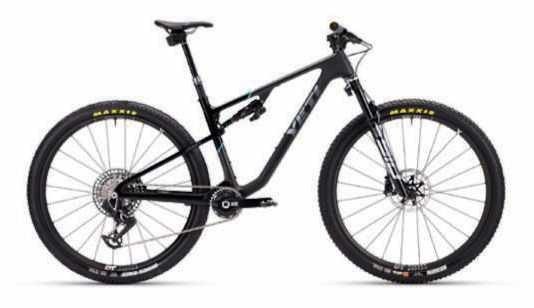
FOR A LOT LESS
Yeti ASR C2
£5,499
Lower-spec carbon fibre, cheaper wheels and a mechanical drivetrain bring the price down significantly.
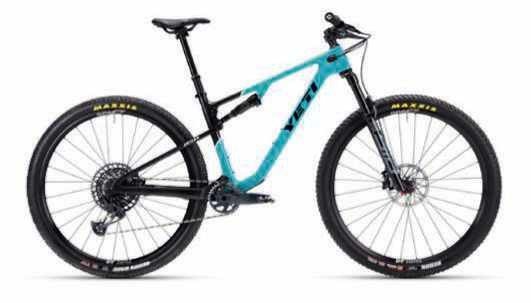
CANNONDALE SCALPEL 1 LEFTY
£8,550
Head-turning race whippet that’s ready to get rad
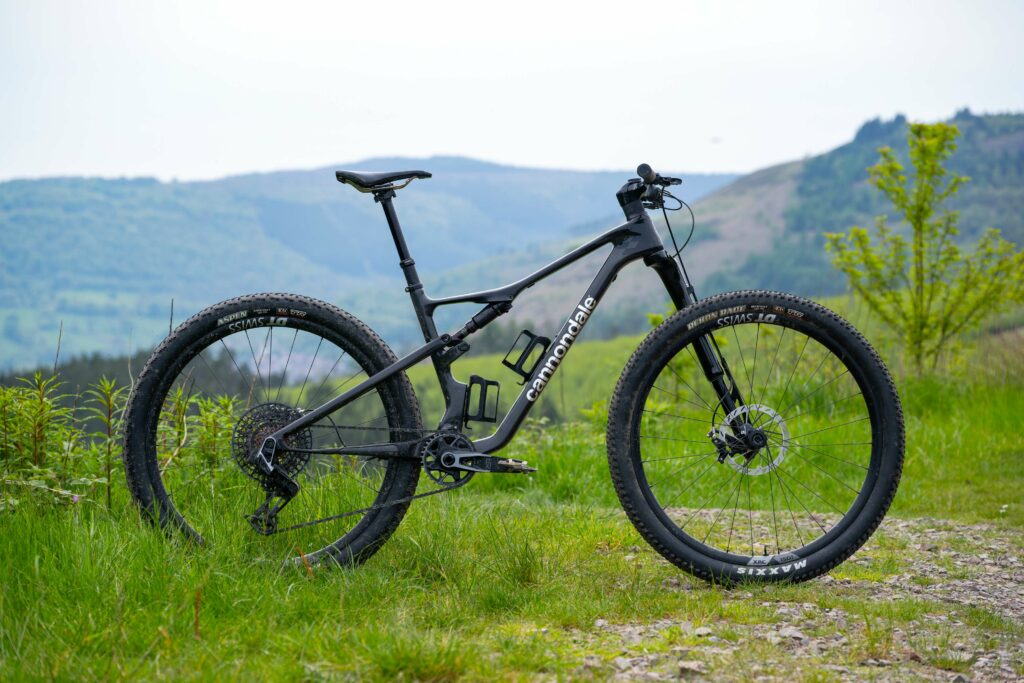
DETAILS
RADICAL LEFTY
Don’t let the single leg give you doubts – the fork chassis is properly stiff, and plenty of vehicles (such as your car!) roll on one-sided hub/wheel interfaces.
FLATTENED CHAINSTAY
This is the flexible part of the rear triangle. It does the same job as a pivot, enabling the suspension to move through its travel effectively.
CLEAN THE BAR
Cannondale’s SystemBar XC One integrated cockpit has a 760mm width and 50mm effective stem length. Cables are routed inside the bar, giving a super-sleek set-up.
The Scalpel has been a regular at the sharp end of XC racing for approaching 20 years, while Cannondale’s signature Lefty forks have been in their line-up for even longer. An update for 2024 sees travel boosted to 120mm.
THE FRAME
Once again, the Scalpel has a flexstay design, although here it’s the chain-stays that bow (thanks to a flattened portion), mimicing a Horst-link pivot. In theory, this means braking and pedalling should have less of an effect on the suspension than on the Yeti. Cannondale’s ‘Proportional Response’ concept sees them tweak pivot points and frame construction to optimise the suspension on each size.
While the other bikes here have three-position lockouts, on the Scalpel you can only choose between open and lock. The cable is neatly integrated into the top tube, though. Two bottle cages can be attached, and there’s rubberised protection fitted to help keep your investment safe.
THE KIT
The standout item here is Cannondale’s own Lefty Ocho Carbon fork, with 120mm of travel, an inverted design and carbon fibre construction. Its single leg houses both damper and air spring, while needle bearings ensure smooth operation. A composite fender keeps the stanchion safe and brake hose secure.
DT Swiss XMC 1501 carbon wheels are fitted with a ruthlessly fast Maxxis Rekon Race and Aspen tyre combo. The one-piece bar/stem looks tidy, while the use of SRAM’s HS2 rotors with the four-piston Level Stealth brakes ensures snappy stopping. A wireless X0 AXS Eagle Transmission provides the drive.

THE RIDE
The lack of a third suspension mode proves no issue on the bike, because Cannondale’s engineers seem to have given the Scalpel just the right mix of pedalling efficiency and big-hit control. Both fork and shock are firm when locked out, and the ultra-fast Aspen and Rekon Race tyres zip along like nothing else. The wheels’ lateral stiffness is matched by that of the chassis, so little power is lost to flex.
There’s enough stability through the back end that if you open up the damping the suspension doesn’t rob any energy, unless you’re pedalling in squares. Still, on fine-graded, gritty climbs we tended to employ the lockout for speed and rely on the suppleness of the 120tpi tyre casings and the shallow but tractor-like tread of the Aspen to provide grip.
The Lefty Ocho Carbon is a great-feeling fork. Chassis stiffness is on-par with other stout XC forks, but its needle bearings and inverted design cope better with harsh landings to flat, where it binds less and delivers its travel smoothly. It’s pretty much immune to mud build-up, too, unlike the Fox 34 Step-Cast, in particular. That said, the Lefty isn’t always the easiest to live with. Removing the wheel leaves the calliper flapping about, because it has to be disengaged from the fork leg, and engaging the hub’s threads would be easier with an extra set of hands.
Handling is spot on. On our large frame, the long 475mm reach and slack 66.6-degree head angle are balanced well with the 442mm chainstays. This ensures your body weight is placed properly between the axles, boosting climbing performance and cornering. Lean the Scalpel over, engage the Rekon Race’s low but sharp shoulder knobs, and the bike rips around corners. On that note, we prefer the squarer profile of the Rekon Race to the rounder shape of the Specialized rubber, as it gives a predictable transition from the centre tread to the shoulder blocks.
HIGHS
Lefty fork is a great addition, with smooth and stiff performance
Sorted frame shape shines in every situation, with no tube lengths or angles needing tweaking
Parts package leaves little to be desired
LOWS
The Lefty isn’t quite as easy to live with as the rest of the bike
Carbon rims are stiffer than some others here
FOR A LOT MORE
Cannondale Scalpel LAB71
£10,000
Top-spec carbon, high-end kit and a stunning paint job make this limited edition race bike a drool-worthy machine.

FOR A LOT LESS
Cannondale Scalpel 2 Lefty
£6,750
Own-brand carbon wheels and a drop to SRAM’s GX Eagle AXS Transmission save a few thousand quid.
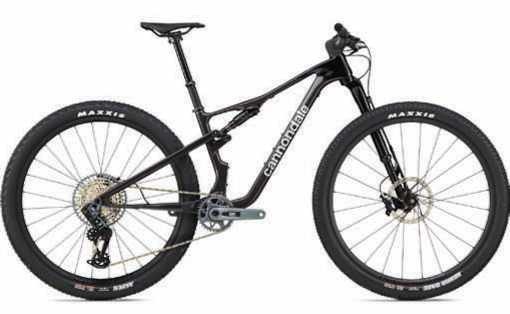
SPECIALIZED EPIC 8 PRO
£8,000
The Brain has gone, but was that a stupid decision?

DETAILS
REMOTE LOCKING
RockShox’s TwistLoc remote is a common sight on XC bikes and offers access to two or three suspension modes, while avoiding interference with under-bar dropper levers.
VALUE RUBBER
Specialized’s own tyres are a popular pocket-friendly purchase, thanks to decent performance and great value for money.
FLAT TOP
The Roval carbon wheels have a widened top to the rim wall, designed to help forces dissipate over a wider area when you bottom-out the tyre, lowering the risk of pinch punctures.
The Epic always used to come with Specialized’s inertia valve-equipped Brain shocks and forks, which stayed locked-out until you hit a bump. While the latest S-Works Epic 8 is fitted with RockShox’s Flight Attendant system, which does the same job electronically, lower-spec bikes, including the 8 Pro tested here, have to make do with a new ‘Magic Middle’ custom shock mode to filter out pedal bob.
THE FRAME
Spesh use their ‘11m’ carbon fibre to create the long, low and slack shape of the Epic 8 Pro. Once again, flexstays help deliver the 120mm of rear-wheel travel – in this case, the seatstays. A flip-chip gives high and low geometry settings. We tested mainly in low, which gives a sub-66-degree head angle.
There’s a storage port in the down tube, plus space for two bottles. Thick protection is fitted on the chainstay and down tube. Cables are routed through the head tube.
THE KIT
As on the Yeti, you get a RockShox SID Ultimate fork and SIDLuxe Ultimate shock. These are controlled via a three-position TwistLoc barrel on the handlebar. The open and firm settings work as you’d expect, while the custom Magic Middle mode with its unusual digressive tune is designed to keep the bike efficient under power, but reactive to bumps, without needing to constantly change suspension modes.
A wireless SRAM X0 Eagle AXS Transmission keeps the Roval Control carbon wheels rolling, while Level Silver brakes bring things to a stop. BikeYoke’s DIVINE SL post has just 125mm of drop – the least here. The rest of the kit comes from Specialized, including the tyres – a fast-rolling Renegade at the rear, paired with a grippier Fast Trak up front.
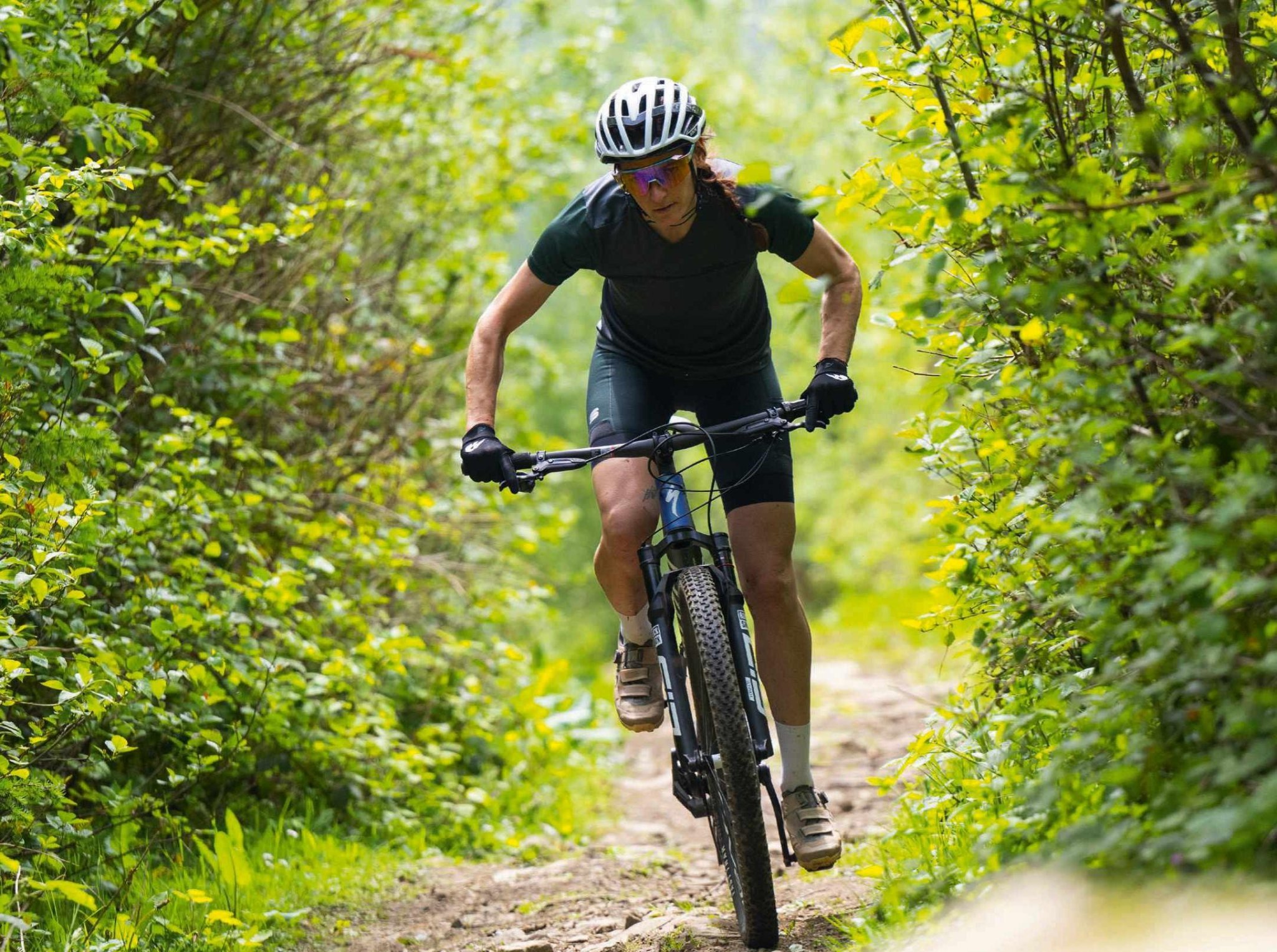
THE RIDE
It’s hard to find much to complain about with the Epic 8 Pro, which seems to work well in virtually every situation, up or down. Specialized’s engineers suggest that around 80 per cent of your time should be spent in the Magic Middle mode, and in testing, that holds up. The firmness around the sag point ensures that little energy is wasted when you’re putting the power down, whether on snaking traverses or on steep, loose climbs. It also keeps the seat tube angle steep for efficient pedalling. There’s just enough ‘give’ to let the Renegade rear tyre dig in and grip, too.
On the smoothest ascents, the lockout is handy, and the chassis remains stiff, while the wireless gears shift well under load. Back in Magic Middle mode, you can pump the bike well to generate speed over rolling terrain, but when you hit mid-to-large hits, the fork and shock open up, enabling plenty of travel to be used to smooth the way. Medium hits are absorbed so well in this setting that we were able to run less sag than on the other bikes – around 22 per cent – boosting pedalling performance.
Open mode is best reserved for long or rough descents. On the biggest hits, progression is smooth to the end, so your ankles are well-protected from impacts. Combined with the quiet, tight-feeling chassis, this gives the Epic 8 a wonderfully refined ride. We never felt like it got out of its depth, even down black runs. This is helped by the Roval wheels, which aren’t super-rigid, so provide welcome comfort and help smooth-out off-camber trails, even if the rear hub pick-up could be quicker.
HIGHS
Custom Magic Middle mode really does work, minimising use of the TwistLoc remote
Chassis blends efficiency-boosting stiffness with comfort and confidence on gnarly tracks
Handling almost feels trail-bike like
LOWS
Rounded tyres make for ‘exciting’ handling in some situations
FOR A LOT MORE
Specialized S-Works Epic 8
£12,000
Higher-spec carbon and RockShox Flight Attendant suspension adjustment contribute to a five-figure price tag.
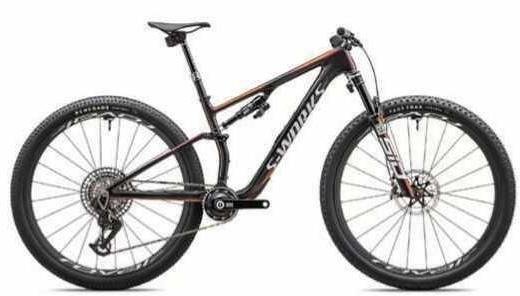
FOR A LOT LESS
Specialized Epic 8 Expert
£6,000
Downgrading to Select+ level RockShox suspension helps bring the price down, while an X-Fusion post offers more drop.
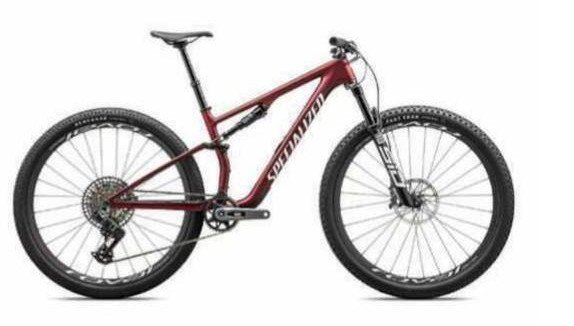
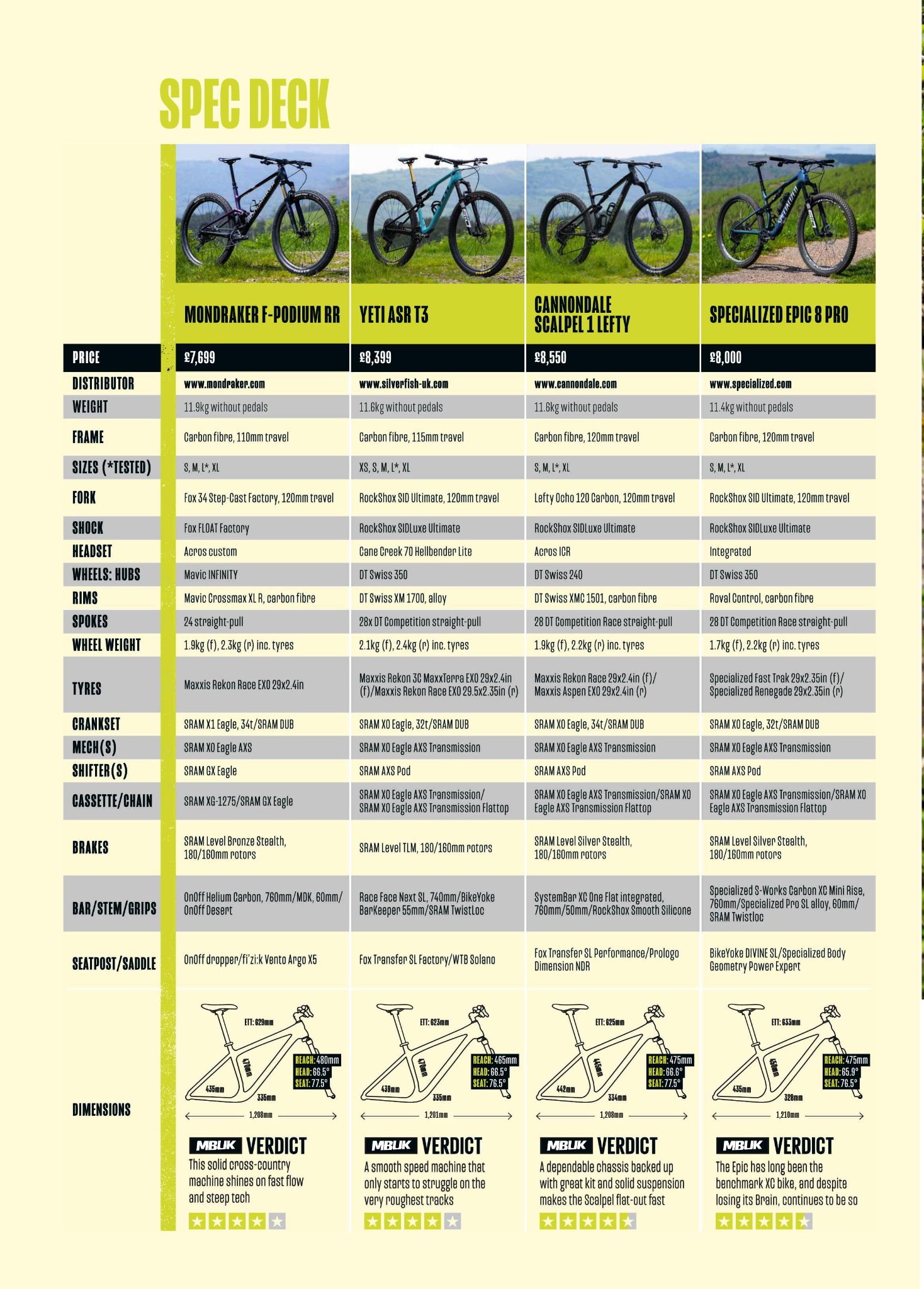

Winner
None of these bikes would hold you back on the race track, and the differences in scoring are based on small details. Our testing put them through anything you might experience on any XC course the world over. While black descents at a bike park may not be representative of UK XC racing (yet!), when you’re crawling around lap six, you need a bike that’s easy to ride, and that’s something those runs helped reveal.
The Yeti ASR T3 is a smooth operator, turning more heads than the others. Over smooth, fast terrain, its ability to generate speed is exhilarating, and for day-long epics, we’d mount this steed in an instant. Its small-volume shock was harder to set-up, though, and became overwhelmed quicker on the techiest of tracks. The Mondraker F-Podium RR, meanwhile, is a bike made for steep terrain and fast flow, with stable suspension that gives confidence when you’re tipping it into a chute. Over high-speed chatter, though, it’s less composed than the others.
Cannondale’s Scalpel 1 Lefty is an out-and-out race bike that still delivers on the trails. The tyres are rapid and the fork impressive, if not as simple to live with as a dual-legged design. This was a bike that was hard to give back. Ultimately, though, it couldn’t quite match the composed speed machine that is the Specialized Epic 8 Pro. In any situation – under power, up steep climbs, on flow tracks and, where it really shone, on the gnarliest trails we could find – the Epic just seemed to thrive, making it our outright winner.